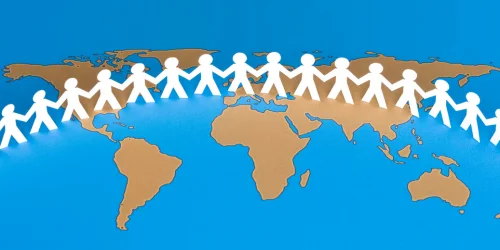Collaboration is paramount: Unveiling geo-specific threats and mitigation strategies.

In the rapidly evolving realm of cybersecurity, understanding the intricacies of cyber threats is paramount to effective defence strategies. One approach that has proven valuable in this pursuit is geo perspective. By analysing cyber data geographically, security professionals gain critical insights into regional cyber threats, vulnerabilities, and attack patterns.
Embracing geo perspective empowers cybersecurity analysts to discern cyber threats specific to geographic locations or regions. Each area faces distinct challenges influenced by geopolitics, economic factors, and technological infrastructures. By understanding regional cyber threats, organisations can tailor their defence strategies to address localised risks proactively. Moreover, this approach helps international cooperation, encouraging the exchange of threat intelligence and best practices to bolster the collective resilience against cyber adversaries.
Some typical examples to illustrate this point are below:

UK:
Disinformation and privacy continue to cause major concerns. The 2021 Online Safety Bill aims to address harmful content and cyberbullying. Over 1,700 data breaches were reported in the first half of 2022, according to the ICO.
The ICO’s ‘Data Security Incidents Dashboard’ revealed that cyber incidents accounted for 25% of all data breaches in 2022. The report goes on to reveal that there was a 133% increase in large scale attacks compared to the previous year, 2021.
According to Sonic Walls Cyber 2023 report, the United Kingdom occupies the second position (behind the US) for the highest volume of malware attacks, reporting 432.9 million attacks in 2022.

US:
Cybercrime and election interference are amongst the top priorities. The 2020 US Presidential election faced renewed cyber risks according to the CNAS think tank. The FBI reported 2,084 ransomware attacks in 2021, costing over $16 billion. But in 2022, the FBI reported Phishing attacks as the number one cybercrime with total losses due to phishing attacks exceeding $10.3 billion.
However, according to the July 2023 Black Fog Ransomware report, exfiltration continues to be the primary weapon of choice for attacks. Leveraging data for extortion contributes to that quarter’s all-time record, with an average pay out of US$740,144. China continues to be the main destination for data loss at 41% with Russia at 9%.

India:
Securing digital payments and avoiding identity theft are urgent issues. Per the Data Security Council of India, 44% of Indian organisations faced a data breach or cyberattack in 2021. The Personal Data Protection Bill seeks to safeguard individual privacy.
Fast forward to 2023, and India comes third on the list (behind US and UK) for the highest volume of malware attacks, totalling 335.4 million, showcasing a noteworthy increase of +31% Year On Year.

Australia:
Combating ransomware and data breaches appears to be key focus areas. The 2022 ACSC Annual Cyber Threat Report highlighted ransomware as the most disruptive threat. Optus and Medibank breaches impacted millions of Australians in 2022.
Sharing different geo cyber threats, trends, insights remain paramount to joining together in a public-private collaboration to tackle the global fight against the hackers.
Sadly, this is not as easy as it seems with different geo political agendas for cyberwarfare data. There have been almost 500 documented geopolitical cyber-attacks worldwide since 2009 making cyberwarfare a major technological threat to nations and their citizens. Between 2009 and 2018, there was a 440% increase in global cyberwarfare attacks – 30% originated in China or Russia.
In contrast, countries like Singapore focus on protecting critical infrastructure from cyber threats (GovTech, 2022). South Korea is battling digital sex crimes and personal data leaks (Do, 2022).

Hotspot detection:
Analysing cyber incidents from a geographical standpoint uncovers hotspots of cyber activity, where certain regions experience higher cybercrime rates or targeted attacks. Finding these hotspots is instrumental in deploying targeted security measures to fortify vulnerable sectors. Organisations can prioritise resources to safeguard critical infrastructures, sensitive data repositories, and vital digital assets in regions more susceptible to cyber threats.

Attribution and investigation:
Geo perspective plays a vital and pivotal role in attributing cyberattacks to specific threat actors or nation-states. By examining cyber incidents through a geopolitical lens, analysts can gain valuable insights into the motivations and intentions behind the attacks. Such information is essential for effective incident response and investigation, enables prompt mitigation by organisations and appropriate diplomatic strategies by governments.

Geopolitical influence:
The impact of cyberattacks often extends beyond technical consequences and delves into the realm of geopolitics. State-sponsored actors are increasingly involved in cyber espionage, cyber warfare, and cyber influence operations. Adopting geo perspective helps cybersecurity professionals understand the broader geopolitical context, enabling organisations and governments to formulate the right diplomatic responses and strategies to limit further escalations.

Collaborative defence measures:
Incorporating geo perspective in cybersecurity strategies fosters a culture of international collaboration and information sharing. Recognising that cyber threats are borderless, the global community can work together to protect the digital ecosystem for the mutual benefit of all. It encourages the establishment of international norms and standards for responsible behaviour in cyberspace, promoting cybersecurity as a shared commitment among nations.
The role of emerging technologies:
As cybersecurity continues to evolve, the adoption of emerging technologies plays a vital role in bolstering defences and enhancing the efficiency of geo perspective. Artificial intelligence and machine learning algorithms can process vast amounts of cyber data, allowing for real-time threat analysis and initiative-taking defence measures. Additionally, blockchain technology can offer secure data storage and decentralised threat intelligence sharing, further enhancing collaboration among cybersecurity stakeholders.

Educating the next generation:
To ensure a sustainable and resilient cybersecurity ecosystem, there must be a strong emphasis on educating the next generation of cybersecurity professionals.
Promoting cybersecurity awareness, ethical hacking practices, and responsible data handling from an early age can cultivate a skilled workforce capable of addressing region-specific cyber threats effectively.
Adopting a geo perspective provides a holistic view of threats while uncovering region-specific risks. Examining cybersecurity geographically allows tailored defences and enables hotspot detection, attribution, and understanding geopolitical implications. This fosters international cooperation for mutual benefit against borderless threats.
As Kofi Annan once wisely stated, “We must unite against common threats and harness common opportunities.” In the borderless realm of cyberspace, we must come together through a shared understanding that geographical differences influence region-specific dangers. Only then can we build collaborative defences, attribute threats more effectively, and grasp the geopolitical context.
Geo perspective and emerging technologies, along with education, are critical to safeguarding our digital future. United by geography and driven by technology, we can build a safer cyber ecosystem. For in the words of Helen Keller, “Alone we can do so little; together we can do so much.” Our cooperation determines our resilience.
Let us embrace geo perspective, forge international collaboration, develop innovative solutions and empower future generations. This multi-faceted approach represents our best chance to meet the challenges of tomorrow and secure the promise of a safe cyberspace.
The task ahead is not easy, but united with shared understanding and common purpose, we can and will safeguard our interconnected world.




